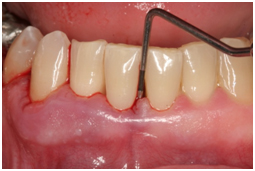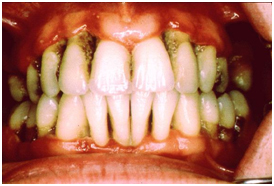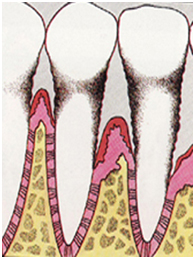Types of Gum Disease
Gingivitis

Gingivitis is the mildest form of periodontal disease. It causes the gums to become red, swollen, and bleed easily. There is usually little or no discomfort at this stage. Gingivitis is often caused by inadequate oral hygiene. Gingivitis is reversible with professional treatment (Scaling and polishing) and good oral home care (Mouth wash, warm saline gargles).
Periodontitis

Untreated gingivitis can advance to periodontitis. With time, plaque can spread below the gum line. Toxins produced by the bacteria in plaque irritate the gums. The toxins stimulate a chronic inflammatory response in which the body in essence turns reacts, and the tissues and bone that support the teeth are broken down and destroyed. Gums separate from the teeth, forming pockets (spaces between the teeth and gums) that become infected. As the disease progresses, the pockets deepen and more gum tissue and bone are destroyed. Often, this destructive process has very mild symptoms. Eventually, teeth can become loose and may have to be removed.
There are many forms of periodontitis. The most common ones include the following.
Aggressive periodontitis occurs in patients who are otherwise clinically healthy. Common features include rapid attachment loss and bone destruction and familial aggregation. Chronic periodontitis results in inflammation within the supporting tissues of the teeth, progressive attachment and bone loss. This is the most frequently occurring form of periodontitis and is characterized by pocket formation and/or recession of the gingiva. It is prevalent in adults, but can occur at any age. Progression of attachment loss usually occurs slowly, but periods of rapid progression can occur. Periodontitis as a manifestation of systemic diseases often begins at a young age. Systemic conditions such as heart disease, respiratory disease, and diabetes are associated with this form of periodontitis.Periodontal Surgery

Necrotizing periodontal disease is an infection characterized by necrosis of gingival tissues, periodontal ligament and alveolar bone. These lesions are most commonly observed in individuals with systemic conditions such as HIV infection, malnutrition and immunosuppression.
If you're diagnosed with periodontal disease, your periodontist may recommend periodontal surgery. Periodontal surgery is necessary when your periodontist determines that the tissue around your teeth is unhealthy and cannot be repaired with non-surgical treatment. Following are the four types of surgical treatments most commonly prescribed:
-
- Pocket Reduction Procedures
- Regenerative Procedures
- Crown Lengthening
- Soft Tissue Grafts
Non-Surgical Treatments
Cosmetic Procedures
In addition to procedures to treat periodontal disease, many periodontists also perform cosmetic procedures to enhance your smile. Many times, patients who pursue cosmetic procedures notice improved function as well. Cosmetic procedures include:- Crown Lengthening
- Soft Tissue Grafts
- Ridge Augmentation
Dental Implants
If you've already lost a tooth due to periodontal disease or other reasons, you may be interested in dental implant the permanent tooth replacement option.Smoking and Periodontal Disease
Recent studies have shown that tobacco use may be one of the most significant risk factors in the development and progression of periodontal disease. In addition, following periodontal treatment or any type of oral surgery, the chemicals in tobacco can slow down the healing process and make the treatment results less predictable.Women and Periodontal Disease
Hormonal fluctuations throughout a woman's life can affect many tissues, including gum tissue. Because periodontal disease is often a "silent" disease, many women do not realize they have it until it reaches an advanced state. However, at each stage of your life, there are steps a woman can take to protect her oral health.Flap procedure for gum disease


You may need surgery for severe gum disease (periodontitis) if it cannot be cured with antibiotics or root planing and scaling. A flap procedure cleans the roots of a tooth and repairs bone damage caused by gum disease. A gum specialist (periodontist) or an oral surgeon often performs the procedure.
Before the procedure, you will be given a local anesthetic to numb the area where the doctor will work on your gums.
Recommended Related to Oral Health
Dental Tips for Looking Younger
Your mouth is more than just a pretty smile. It's also a gateway to your overall health. Keeping that gateway clean may keep you healthier longer -- and looking younger. "Just as white, straight teeth convey youth, a smile with crooked, discolored, worn, or missing teeth is associated with an aged look," says Edmond Hewlett, DDS, professor of restorative dentistry at UCL's School of Dentistry. "The adage 'long in the tooth,' used to describe older persons, reflects the fact that gum disease causes...What To Expect After Surgery
Typically it takes only a few days to recover from a flap procedure. Be sure to follow the home care instructions that your dentist or oral surgeon gives you. If you have questions about your instructions, call the dentist or surgeon. The following are general suggestions to help speed recovery:- Take painkillers as prescribed.
- After 24 hours, you can rinse your mouth gently with warm salt water several times a day to reduce swelling and relieve pain.
- Change gauze pads before they become soaked with blood.
- Relax after surgery. Strenuous physical activity may increase bleeding.
- Eat soft foods such as gelatin, pudding, or light soup. Gradually add solid foods to your diet as the area heals.
- Do not lie flat. This may prolong bleeding. Prop up your head with pillows.
- Continue to carefully brush your teeth and tongue.
- Apply an ice or cold pack to the outside of your mouth to help relieve pain and swelling.
- Do not use sucking motions, such as when using a straw to drink.
- Do not smoke.

Dental Tips for Looking Younger article
The doctor will pull back a section of your gums to clean the roots of your teeth and repair damaged bone, if needed. The gum flap will be sewn back into place and covered with gauze to stop the bleeding.Bone may be:- Smoothed and reshaped so that plaque has fewer places to grow.
- Repaired (grafted) with bone from another part of the body or with man-made materials. The doctor may place a lining on the bone graft to help the bone grow back. The lining may need to be removed later.




